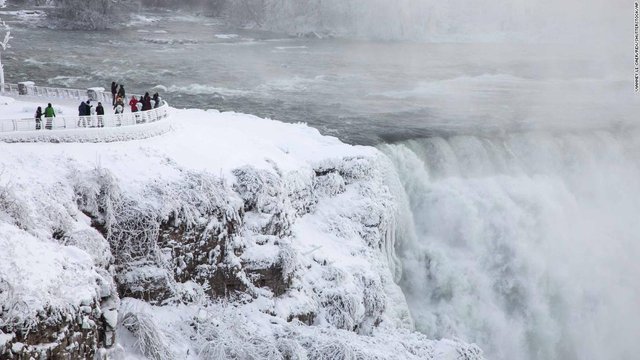The STRANGE Connection Between VOLCANO Eruptions, FREEZING Cold Weather & SUNSPOTS


As we enter the new year, most of North America is gripped in record setting cold. Mount Washington Observatory in New Hampshire recorded a windchill of -100°F during the first week of January. Conditions this extreme will cause bare skin to become frostbitten in 30 seconds, and permanent damage takes just a few minutes of exposure. Temperatures cold enough to freeze iguanas living in the canopies of trees as far south as Florida has had the reptiles raining down onto unsuspecting citizens. While some unusually cold weather doesn’t lead most people to wonder about cosmic or volcanic causes, there are some solar possibilities that may have been overlooked.
As millions try their best to keep warm, the sun is displaying fewer sunspots and emitting less energy as it heads towards a solar minimum. The solar minimum/maximum cycles take on average 11 years, and this current minimum cycle is predicted to hit its lowest point in 2019.
Sunspots large enough to be seen by the unaided eye have been mentioned throughout history, the earliest record of a sunspot drawing was in 1128 by John of Worcester. By the early 1600’s the telescope had been invented, this coupled with other technologies such as camera obscura, allowed astronomers like Galileo and Johannes Kepler to make detailed observations of the sun’s surface. These early sun viewers were amazed to witness black spots moving across the solar surface, they began counting them and keeping records, which were well established by the time of the Maunder Minimum.
The Maunder Minimum started in 1645 and didn’t end until 1715. This period of time was characterized by unusually low amounts of energy being emitted by the sun and lower than average global temperatures. Astronomers noted that the number of sunspots dropped from the typical 40,000-50,000 to less than 50.
One of the largest volcanic eruptions to occur during the last 600 years happened during the Maunder Minimum. This was the eruption of Papua New Guinea’s Long Island volcano. Researchers at The Australian National University said in November of 2017, “Our best estimate places the eruption between 1651 and 1671 AD with a 95.4% probability.” This event sent more than 2.5 cubic miles of ash into the atmosphere, this ash which was combined with volcanic gases such as sulfur, reflected quite a bit of sunlight intensifying the cooling already being experienced due to the solar minimum.
But how could what happens on the surface of the sun 92 million miles away from us cause volcanic eruptions?
An article published in the Journal of Geophysical Research sought to investigate any possible connection between solar minimum and an uptick in volcanic activity here on earth.
The researchers found a correlation between the sun and volcanoes and believe solar flares are to blame, or the lack thereof. Solar flares smack the earth’s atmosphere with such force, that they disrupt the normal wind circulation patterns. This disturbance in the atmospheric ocean jarringly alters the earth’s spin, which in turn triggers a series of small earthquakes, thereby allowing the pent-up stresses to be released in less cataclysmic events.
Earthquake-prone areas that experience severe low-pressure systems experience a similar phenomenon, when a storm rolls in and the atmospheric pressure drops, it allows the region to rise up slightly, releasing the potential energy in numerous tiny non-destructive tremors.
March 20th, 2017 had solar observatories looking at a sun that was displaying no sunspots. Less than 5 months later, two Indonesian volcanoes began acting up. Mount Sinabung on the island of Java began spewing ash on August 2nd. Mount Agung on the island of Bali began rumbling on August 10th and by September, officials had ordered the evacuation of more than 122,000 people living near the volcano. 844 earthquakes were recorded on September 25th. It wasn’t until late November that the mountain began spewing ash 2.5 miles high into the atmosphere, prompting the nearby airport to ground flights.
On January 5th, 2018, Kadovar Island, which is near Papua New Guinea, began erupting without warning. This is the first time in living memory that this volcano has erupted, forcing locals to flee for their lives.
Could the arctic temperatures being felt across most of North America be at least partially due to solar weather and resultant volcano eruptions? The answer maybe Beyond Science.

REFERENCE SOURCES :


If you are interested in various domains of Science and Mathematics then join the @steemSTEM project, team to support high quality STEM(Science,Technology, Engineering and Mathematics) related contents. Join them in steemit.chat to interact with the science authors from all over the world.

This is the beauty of one of the most beautiful volcano in the Philippines which erupted a while ago. :(
Mesmerizing beauty!! :)
Tub Cat is very impressed at the quality of your post. So impressed that he has pushed the little green squishy thing with an upwards pointing arrow to show his appreciation.
Tub Cat has also listed your post for inclusion in his Activity Report which is published weekly.
Tub Cat strives to encourage the production of quality content on Steemit, and has made it is mission to both reward quality content and also offer advice to new comers about how to best go about producing quality content.
Tub Cat has enjoyed your post and encourages you to keep producing such excellent content!
Thanx a lot @tubcat!! :)